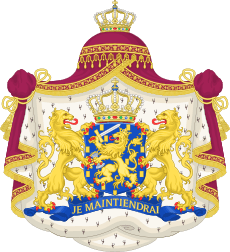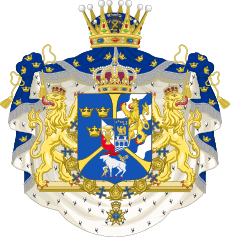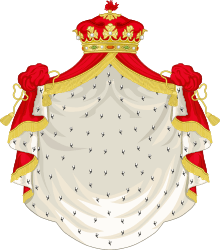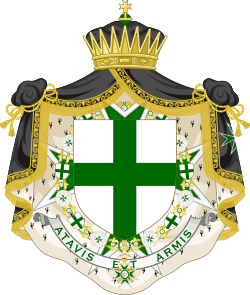Mantle and pavilion (heraldry)
In heraldry, a mantle is a symbol of sovereign power and is generally reserved for royalty. In some cases, its use has also been granted to other nobles, in recognition of particular merits. In ordinary rendering, the mantle is usually crimson and lined with ermine.

Mantle with a pavilion on top
Certain coats of arms may also display a pavilion surmounting the mantle. The pavilion is said to be the invention of the Frenchman Philip Moreau.[1]
While common in continental European heraldry, the mantle and pavilion is absent in English heraldry.[2]
Gallery
Royal mantles
 Napoleonic heraldic mantle and pavilion, topped by a Napoleonic crown
Napoleonic heraldic mantle and pavilion, topped by a Napoleonic crown Arms of the Dutch monarch, with a mantle and pavilion
Arms of the Dutch monarch, with a mantle and pavilion Greater arms of Sweden, featuring a purple mantle but with no pavilion
Greater arms of Sweden, featuring a purple mantle but with no pavilion King Carl XVI Gustaf of Sweden's former arms as crown prince, with a blue mantle reflecting the Swedish princely mantle
King Carl XVI Gustaf of Sweden's former arms as crown prince, with a blue mantle reflecting the Swedish princely mantle
Non-royal mantles
 Mantle and princely hat of a Prince of the Holy Roman Empire
Mantle and princely hat of a Prince of the Holy Roman Empire Heraldic ornaments of a duke and peer of France
Heraldic ornaments of a duke and peer of France Mantle and coronet of a Grandee of Spain
Mantle and coronet of a Grandee of Spain- Historical mantle and chapeau of a Scottish feudal baron
Order mantles
.svg.png) Spanish Monarch's arms with the mantle of the Order of Charles III
Spanish Monarch's arms with the mantle of the Order of Charles III
Until 1931 Arms of Maximilian von Fürstenberg with the mantle of the Order of the Holy Sepulchre
Arms of Maximilian von Fürstenberg with the mantle of the Order of the Holy Sepulchre Armes of the Order of Saint Lazarus with mantle
Armes of the Order of Saint Lazarus with mantle
gollark: And allows animation.
gollark: HEIF/HEIC is twice as space efficient as JPEG, see.
gollark: Windows *can* read them, it just isn't very well supported.
gollark: What? It's actually a good format.
gollark: Also wireless communications technology and fancy new electronic materials/semiconductor magic.
See also
| Wikimedia Commons has media related to Heraldic mantling. |
References
- Fox-Davies, Arthur Charles (1909). A Complete Guide to Heraldry. London & Edinburgh: T.C. & E.C. Jack. p. 401.
- Fox-Davies, Arthur Charles (1909). A Complete Guide to Heraldry. London & Edinburgh: T.C. & E.C. Jack. p. 400.
This article is issued from Wikipedia. The text is licensed under Creative Commons - Attribution - Sharealike. Additional terms may apply for the media files.